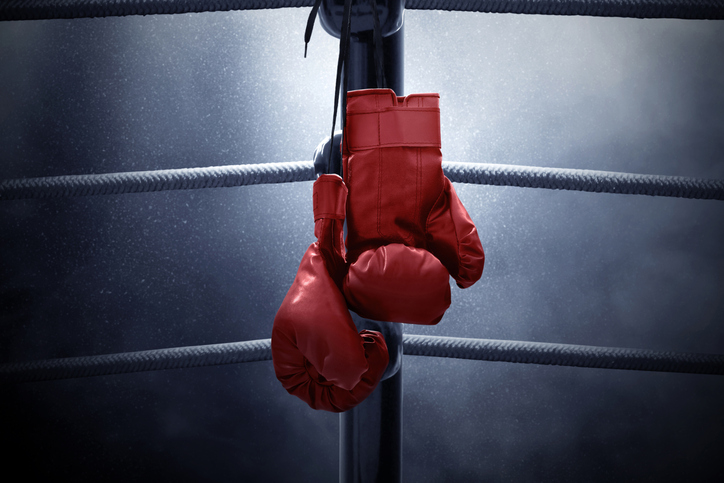By Nitin K Sethi, MD @neurorounds
Professional boxing and mixed martial arts (MMA) are popular sports with a worldwide fanbase. COVID-19 (coronavirus disease 2019) is the infectious respiratory disease caused by SARS-COV 2 virus (Severe Acute Respiratory Syndrome coronavirus 2). On March 11th, 2020 The World Health Organization (WHO) declared COVID-19 a pandemic considering the over 118,000 cases of the coronavirus illness in over 110 countries and territories around the world and the sustained risk of further global spread. 1 In order to control the spread of COVID-19, heath care authorities in different countries recommended isolation of sick persons, quarantine for those who may been exposed to the virus and social distancing. 2 Social distancing also referred to as physical distancing means keeping space between people outside of their homes. A distance of at least 6 feet (2 meters) was recommended and people have been asked not to gather in large groups, avoid crowded places and mass gatherings. Widespread cancellation or postponement of sporting events including boxing and MMA bouts followed. The most common sited cause for cancellation was fear of contagion. The encyclopedia describes contagion as the communication of disease from one person to another by close contact. By canceling events, State Commissions, promoters and combat sport’s governing bodies made the tough but responsible decision to protect all the concerned parties namely the athletes, their camps, Commission officials, production crews and the fans at the venue.
Amid the COVID-19 pandemic should combat sports events be held “behind closed doors”?
The global death toll from COVID-19 has been devastating. COVID-19 has infected more than 2 million people and killed at least 132,276 worldwide as of April 15th 2020 according to the coronavirus resource center at Johns Hopkins University. 3 The pandemic affected each and every one of us fundamentally changing the way we live our lives. The pandemic has peaked in many European countries and the United States. While deaths continue to mount, new cases and admissions are declining. Governments are now turning to the complex question of how and when to open different states and countries to business and normal life. For combat sports to resume this summer we should explore the possibility of initially holding events “behind closed doors”.
The term “behind closed doors” is used primarily in association with football (soccer) to describe matches played where spectators are not allowed in the stadium to watch. Soccer matches are played behind closed doors to punish a team when its fans display rowdy behavior and clash with the rival team supporters and is included in the FIFA Disciplinary Code. 3
Crowd-less bouts are rarely heard of in combat sports. Passionate, and frequently blood hungry fans vociferously and voraciously support their prizefighter. They are as much a part of the sport as the athletes themselves. Combat sports athletes fight not just for fame and money, they fight for their fans in the venue. Holding a crowd-less event takes the very essence and vibe out of a combat sports event. Just like water is the elixir of life, so is the combat sports fan to the sport itself.
How would bouts begin again?
If an event were to be held behind closed doors, only the athletes, cornermen, referee, judges, Commission officials, ringside physicians and TV production crew would be present at the venue. The rationale for holding an event behind closed doors will be to reduce the risk of COVID-19 transmission from person-to-person by restricting the number of people at the venue to under 50. In the past month, many SARS-COV 2 diagnostic test kits have become available. Some of these can be administered at the point-of-care with a turnaround time of 24 hours. It is proposed that all (not just combatants) present at the closed door event undergo a coronavirus screening questionnaire and be tested for SARS-COV 2 in the week leading up to the event. Social distancing should be practiced at the time of the weigh-ins and also the event itself. Corner men, referee, judges, Commission officials, ringside physicians and TV production crew should wear a surgical face mask (N 95 respirator is not warranted), gloves and eye-protection during the course of the event.
We should acknowledge that even if an event is held behind closed doors and all those present (not just the athletes) are tested for the coronavirus, the risk of transmission from person to person remains. Controlling the spread of the COVID-19 pandemic is far bigger than any boxing or MMA event. It is a matter of social responsibility and an obligation to act for the benefit of the society at large. By adopting some of the above practices a cautious start to combat sports events can be contemplated.
***
Nitin K Sethi, MD @neurorounds. Department of Neurology, New York-Presbyterian Hospital, Weill Cornell Medical Center, New York, NY (U.S.A.). Email: sethinitinmd@hotmail.com
Disclosures
NKS serves as Associate Editor, The Eastern Journal of Medicine and Editor-in-Chief, ARP Journal of Combat Sports Medicine. He also serves as Chief Medical Officer of the New York State Athletic Commission (NYSAC). The views expressed are his and do not necessarily reflect the views of the NYSAC.
References
- Cucinotta D, Vanelli M. WHO Declares COVID-19 a Pandemic. Acta Biomed. 2020;91:157-160. doi: 10.23750/abm.v91i1.9397.
- https://www.cdc.gov/coronavirus/2019-ncov/prevent-getting-sick/social-distancing.html
- FIFA Disciplinary Code 2017 edition. https://resources.fifa.com/image/upload/fifa-disciplinary-code-500275.pdf?cloudid=koyeb3cvhxnwy9yz4aa6
